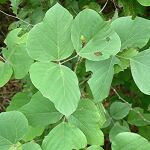| Common Name: |
Ge Gen |
| Other Names: |
Japanese Arrowroot, Kudzu, Kudzu Vine, Pueraria Root |
| Botanical Name: |
Pueraria lobata syn. P. thunbergiana, Pueraria Montana |
| Genus: |
Pueraria |
| Family: |
Papilionaceae |
| Native Location: |
China, Japan, and Pacific Islands. |
| Cultivation: |
Moist, well-drained soil in sun or partial shade. Train and prune regularly to control growth. May be grown as an annual. Remove all pieces of root when harvesting to avoid unwanted regrowth. Extremely invasive weed in warm areas. |
| Propagation: |
By seed sown in spring at 13-18°C (55-64°F); by division in spring; by layering during the growing season. Seeds germinate more quickly if soaked before sowing. |
| Harvest: |
Roots are lifted from autumn to spring and used fresh as juice, or dried for use in decoctions and powders. Flowers are picked before fully open and dried for use in decoctions. |
| Height: |
20m (70ft) |
| Hardiness: |
Z7-10 |
| Parts Used: |
Roots (ge gen), flowers (ge hua). |
| Properties: |
A sweet, cooling, tonic herb that increases perspiration, relieves pain, relaxes spasms, lowers blood pressure, and soothes the digestive system. |
| Medicinal Uses: |
Internally for colds, influenza, feverish illnesses, thirst in diabetes, and muscular tension in neck and shoulders; also for acute conditions, such as stiff neck and sudden deafness (roots), gastritis, nausea and vomiting, alcohol poisoning, and abdominal bloating (flowers). Often combined with the flowers of Chrysanthemum x moriflorum (See, Florist's Chrysanthemum) for alcoholism, hangovers, and alcohol poisoning. Externally for snake bite (roots). Ground root is widely used in remedies for colds, influenza and minor digestive problems.
To treat measles, irregular heartbeat, breast pain, fever, diarrhea, diabetes, traumatic injuries, and psoriasis; to relieve the symptoms of alcoholic hangover. |
| Typical Dose: |
A typical dose of kudzu for the treatment of chronic alcoholism is approximately 1.2 gm of kudzu root extract two times daily for four months. |
| Drug Interactions: |
| Taking kudzu with these drugs may enhance the effects of the drugs: |
| Acebutolol, (Novo-Acebutolol, Sectrol) |
Adenosine, (Adenocard, Adenoscan) |
Amiodarone, (Cordarone, Pacerone) |
Bretylium, (Bretylium) |
| Digitalis, (Digitek, Lanoxin) |
Diltiazem, (Cardizem, Tiazac) |
Disopyramide, (Norpace, Rhythmodan) |
Dofetilide, (Tikosyn) |
| Esmolol, (Brevibloc) |
Flecainide, (Tambocor) |
Ibutilide, (Corvert) |
Lidocaine, (Lidoderm, Xylocaine) |
| Mexiletine, (Mexitil, Novo-Mexiletine) |
Moricizine, (Ethmozine) |
Phenytoin, (Dilantin, Phenytek) |
Procainamide, (Procanbid, Pronestyl-SR) |
| Propafenone, (GenPropafenone, Rhythmol) |
Propranolol, (Inderal, InnoPran XL) |
Quinidine, (Novo-Quinidin, Quinaglute DuraTabs) |
Sotalol, (Betapace, Sorine) |
| Tocainide, (Tonocard) |
Verapamil, (Calan, Isoptin SR) |
| Taking kudzu with these drugs may increase the risk of hypoglycemia (low blood sugar): |
| Acarbose, (Prandase, Precose) |
Acetohexamide, (Acetohexamide) |
Chlorpropamide, (Diabinese, Novo-Chlopropamide) |
Gliclazide, (Diamicron, Novo-Gliclazide) |
| Glimepiride, (Amaryl) |
Glipizide, (Glucotrol) |
Glipizide and Metformin, (Metaglip) |
Gliquidone, (Beglynor, Glurenorm) |
| Glyburide, (DiaBeta, Micronase) |
Glyburide and Metformin, (Glucovance) |
Insulin, (Humulin, Novolin R) |
Metformin, (Glucophage, Riomet) |
| Miglitol, (Glyset) |
Nateglinide, (Starlix) |
Pioglitazone, (Actos) |
Repaglinide, (GlucoNorm, Prandin) |
| Rosiglitazone, (Avandia) |
Rosigilitazone and Metformin, (Avandamet) |
Tolazamide, (Tolinase) |
Tolbutamide, (Apo-Tolbutamide, Tol-Tab) |
|
| Lab Test Alterations: |
- May decrease blood glucose levels.
- May decrease blood cholesterol levels.
|
| Disease Effects: |
This herb may have estrogen-like effects and should not be used by women with estrogen-sensitive breast cancer or other hormone-sensitive conditions. |
| Supplement Interactions: |
May increase the action of herbs and supplements that have estrogen activity, such as Black Cohosh, Chaste Tree Berry, and Soy. |
| Culinary Uses: |
Root yields very fine arrowroot, used in Japanese cuisine to thicken sauces and soups, make noodles and coatings for tempura, and as a gelling agent. Popular in macrobiotic and vegetarian cooking. |
| Bibliography: |
Encylopedia of Herbs by Deni Brown Copyright ©: 1995, 2001 Dorling Kindersley Limited pg 336
The Essential Herb-Drug-Vitamin Interaction Guide by Geo. T. Grossberg,MD and Barry Fox,PhD. Copyright©2007 Barry Fox,PhD. Pp.301-302 |

